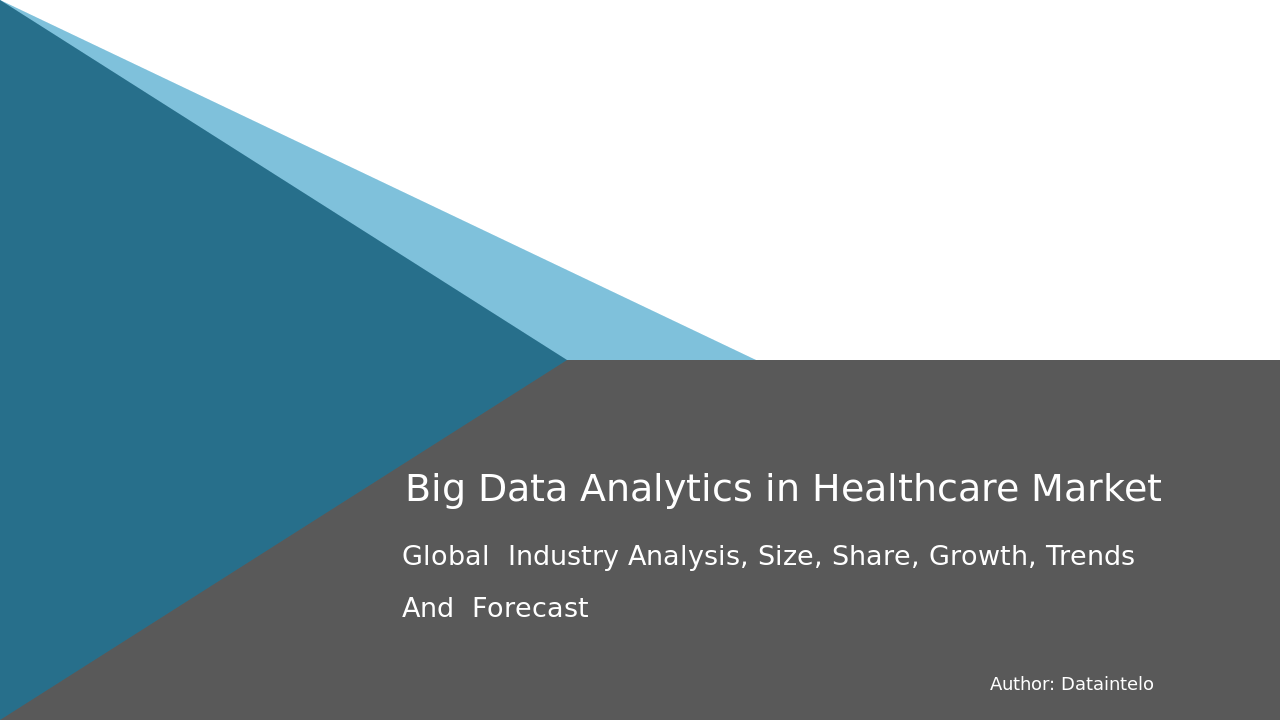
The Big Data Analytics in Healthcare Market is witnessing exponential growth as healthcare systems across the globe integrate advanced digital solutions to enhance patient care, streamline operations, and optimize outcomes. With the increasing digitization of patient records, the need to manage, analyze, and derive actionable insights from massive datasets is becoming a top priority for the healthcare industry.
This market is being propelled by a variety of drivers including technological innovation, growing healthcare expenditures, and the rising prevalence of chronic illnesses. Hospitals, pharmaceutical firms, and clinical research organizations are embracing big data to predict patient risk, improve diagnostic accuracy, and support evidence-based decisions. As AI and machine learning models become more sophisticated, the possibilities for real-time analytics and predictive modeling are expanding significantly.
On the flip side, market growth faces several restraints. Data privacy and security concerns are major challenges, especially with strict regulatory frameworks like HIPAA and GDPR. Additionally, the lack of standardization in data formats and interoperability issues between different systems can hinder seamless data integration. High implementation costs and the need for skilled professionals also act as barriers to widespread adoption.
Request a Sample Report: https://dataintelo.com/request-sample/72084
Despite these restraints, the Big Data Analytics in Healthcare Market is brimming with opportunities. The emergence of telemedicine, wearable health devices, and IoT-based patient monitoring systems has led to a surge in data generation, creating new pathways for data-driven healthcare innovation. Moreover, governments and private entities are increasingly investing in digital infrastructure, boosting the demand for advanced analytics solutions.
Global market dynamics suggest a promising future. The market was valued at USD 24.6 billion in 2023 and is projected to grow at a CAGR of 17.8% during the forecast period of 2024 to 2032. North America currently leads the market due to advanced healthcare infrastructure and widespread adoption of digital technologies. However, Asia-Pacific is expected to witness the fastest growth owing to improving healthcare access and rising awareness.
Here are some key insights into the market:
- Market Size (2023): USD 24.6 billion
- Projected CAGR (2024–2032): 17.8%
- Major Growth Drivers: Increasing chronic disease prevalence, adoption of AI and ML, government digital initiatives
- Key Restraints: Data security concerns, high setup costs, interoperability issues
- Opportunities: Rise in wearable tech, cloud-based analytics, emerging economies’ digital transformation
Big data analytics is transforming every aspect of the healthcare value chain—from diagnostics to patient management. Real-time analytics tools are being increasingly deployed to track disease outbreaks, manage hospital workflows, and even predict patient admissions and discharges. The integration of natural language processing (NLP) enables analysis of unstructured data like physician notes and medical transcripts, further broadening the utility of big data.
View Full Report: https://dataintelo.com/report/big-data-analytics-in-healthcare-market-report
Another prominent market trend is the shift toward precision medicine. Big data empowers healthcare providers to tailor treatments based on genetic, lifestyle, and environmental factors. This approach not only improves clinical outcomes but also reduces the trial-and-error aspect of conventional treatments. By leveraging predictive analytics, care teams can foresee disease progression and intervene earlier, thereby lowering healthcare costs and enhancing patient satisfaction.
The market is also seeing strong momentum from cloud-based solutions. Cloud computing allows for scalable, flexible, and cost-efficient storage and processing of healthcare data. It facilitates better collaboration among healthcare stakeholders while ensuring data accessibility anytime, anywhere. With ongoing innovations, cloud platforms are becoming increasingly secure and compliant, addressing some of the earlier concerns around data integrity.
Enquire Before Buying: https://dataintelo.com/enquiry-before-buying/72084
In terms of application, clinical analytics remains the largest segment, driven by demand for tools that can analyze EHRs and support clinical decision-making. Financial analytics is also growing rapidly, helping healthcare providers reduce fraud, optimize billing, and improve revenue cycle management. Operational analytics, which focuses on enhancing efficiency in hospital operations and logistics, is another burgeoning area.
The integration of big data into healthcare also supports public health initiatives. Governments and health organizations are using data analytics to track epidemiological trends, evaluate the impact of interventions, and allocate resources more effectively. During the COVID-19 pandemic, big data played a critical role in monitoring transmission rates, hospital readiness, and vaccine distribution strategies.
Looking ahead, interoperability and data governance will be pivotal for market sustainability. Stakeholders need to collaborate on creating uniform standards and protocols that enable seamless data sharing and integration across platforms. Moreover, ethical considerations around data use and algorithmic bias must be addressed proactively to ensure equitable healthcare delivery.
Check Out the Report: https://dataintelo.com/checkout/72084
In conclusion, the Big Data Analytics in Healthcare Market is poised for remarkable expansion. As technological capabilities continue to evolve and healthcare becomes increasingly data-centric, the sector offers immense potential for innovation, efficiency, and improved patient outcomes. With rising investments, supportive policies, and growing awareness, the future of healthcare is undoubtedly data-driven.